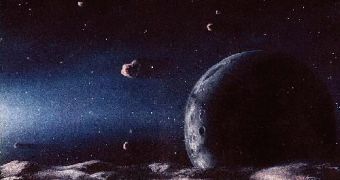The smallest of the Kuiper Belt Objects remain elusive for all the searches attempted over the past few years. Finding some would help explain a number of theories related to the solar system's formation and evolution.
Since the icy ring of frozen bodies known as the Kuiper Belt was discovered beyond Neptune in 1992, more than 1,000 of its residents were found. Analyzing them proved that the number of the small ones was bigger than that of larger Kuiper Belt Objects (KBO). Still, the precise distribution remains unknown, since only a few smaller than 70 km across were discovered, as they reflect way too little sunlight to be spotted. The smallest ever found reached about 30 km across in size and were seen by the Hubble Space Telescope. Although so few of them were actually seen, predictions claim that the small KBOs should be 25 times more abundant, based on their larger counterparts' distribution. Either way, scientists don't know exactly what to expect from really small bodies.
Charles Alcock, director of the Harvard-Smithsonian Center for Astrophysics (CfA) in Cambridge, Massachusetts, together with an international group of fellow astronomers, developed the so-called Taiwanese-American Occultation Survey, a technique that would help track down the tiniest objects (3 to 28 km across).
Basically, the technique traded searching for a KBO's reflected light for the search of its shadow, using three 50-centimetre telescopes in Taiwan that enables the analysis of 200 to 2,000 stars at the same time. The tricky part is that a KBO would only cast a shadow for a second while passing between a star and the observer. Since 2004, when the project began, Alcock hoped to get 10 positive results per year. Instead, he came up with none. “We need to run the experiment for longer and we need to push that [limit] down until we find something,” he said, as quoted by New Scientist. “Then we'll be able to say, 'This is how many there are.'”
Besides determining their composition, reaching an accurate estimation of KBOs would also prove useful in revealing the way our solar system looked like when it was young, before planet migration, as well as providing clues of “the physical processes going on around Neptune, just before and just after” that respective period, as Alcock hopes.

 14 DAY TRIAL //
14 DAY TRIAL //